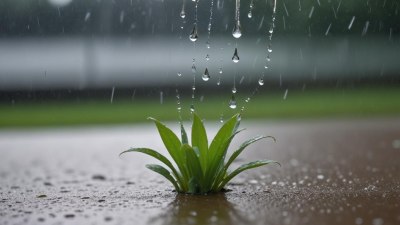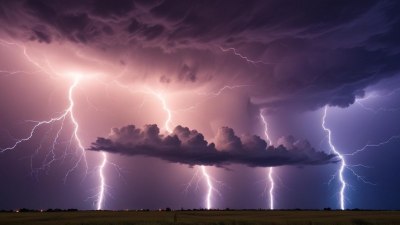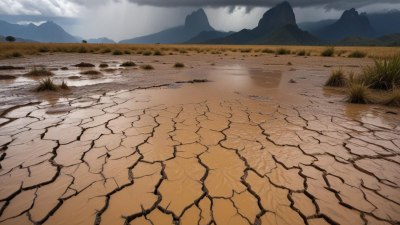Why Some Raindrops Evaporate Before Hitting the Ground
Discover the science behind raindrop evaporation and why some don't reach the ground.

This image was created with the assistance of Freepik
Raindrops are a fundamental element of our weather system, yet not all droplets make it to the earth's surface. Some evaporate while still suspended in the atmosphere. This phenomenon can be attributed to several layered interactions between the environmental conditions, droplet size, and the composition of the atmosphere. In this article, we delve into the fascinating world of meteorology to uncover the reasons why certain raindrops evaporate before hitting the ground and the implications for our climate and weather patterns.
The Process of Rain Formation
To understand the evaporation of raindrops, we must first explore how rain forms. Raindrops originate from clouds. When water vapor in the atmosphere condenses on tiny particles, such as dust or pollen, it forms small water droplets. As these droplets collide and merge, they grow larger. Eventually, the droplets become heavy enough to overcome the upward forces of air and fall to the ground as rain.
Factors Influencing Evaporation
The key factors that determine whether a raindrop reaches the ground include temperature, humidity, wind conditions, and droplet size. Each of these elements plays a vital role in the evaporation process.
Temperature's Role
Higher temperatures can enhance evaporation rates. When a raindrop falls through warmer air, the water begins to evaporate before it reaches the ground. The warmer the air, the more energy it possesses, which allows it to absorb moisture from the falling droplets.
Humidity Levels
Humidity is another crucial factor. In an environment where air is already saturated with water vapor (high humidity), the evaporation process slows down significantly. Conversely, in arid or dry conditions (low humidity), raindrops can evaporate almost instantly as they fall through the atmosphere.
Wind Conditions
Wind can also affect raindrop size and its potential to reach the ground. Strong winds can cause raindrops to break apart into smaller droplets, which may have a higher chance of evaporating before hitting the surface due to their reduced size. Additionally, wind can carry droplets away from their original fall path, influencing their chances of reaching the ground.
Droplet Size
The size of the raindrop is a significant factor in determining its fate. Smaller droplets evaporate faster than larger ones due to the higher surface-area-to-volume ratio. For instance, mist and drizzle consist of tiny droplets that are easily evaporated compared to heavier rainfall where larger droplets have a better chance of survival.
The Lifecycle of a Raindrop
The lifecycle of a raindrop is incredibly dynamic, influenced by various atmospheric conditions. Understanding the lifecycle helps to explain why specific droplets can evaporate en route to the ground. When a droplet begins its descent, it navigates through different atmospheric layers, each with varying temperatures and conditions, effectively impacting its chances of making it to the ground.
Environmental Impacts
The evaporation of raindrops before they hit the ground not only affects local weather but can also have broader environmental impacts. Reduced rain reaching the ground means less water available for the soil, which can lead to drier conditions, especially in agricultural zones.
Effects on Agriculture
Farmers and agriculturalists always need reliable rainwater for their crops. When rain evaporates before hitting the ground, the soil doesn't receive enough moisture, which can endanger crops’ health and yield. This can induce farmers to rely more on irrigation and other practices to compensate for the lack of natural rain.
Impact on Climate
The ability of raindrops to evaporate before reaching the ground is also an indicator of climate change effects. With shifts in temperature and patterns of humidity as a result of global warming, the likelihood of evaporation before reaching the ground may increase, further affecting moisture availability in some regions.
Case Studies
There have been several studies aimed at understanding the phenomenon of raindrop evaporation. Research using weather balloons, radar technology, and satellites gives scientists the data needed to analyze evaporation rates in real-time and predict impacts on local weather patterns. This treasure trove of data allows for more accurate weather forecasting, enhancing our understanding of precipitation dynamics.
Urban Water Cycles
Cities can also have an influence on raindrop evaporation. Urban areas, with their heat islands and pollution, can create conditions for higher evaporation rates. The thermal dynamics in such areas can contribute to localized weather effects where more rain evaporates before reaching the ground, affecting not just the residents but the entire ecosystem.
Adaptive Mechanisms
The environment has adapted to a degree to changes in raindrop evaporation through vegetation and topography. Trees and plants can help capture falling droplets, allowing more moisture to enter the soil system, which mitigates the effects of evaporation. This adaptation underscores the interconnectedness of ecosystems and weather.
In conclusion, the evaporation of raindrops before they reach the ground is a complex interplay of environmental factors, including temperature, humidity, wind conditions, and droplet size. While this phenomenon can lead to reduced moisture availability for agriculture and local ecosystems, understanding the contributing factors helps meteorologists enhance weather forecasts and adapt strategies in agriculture. As our climate continues to change, observing and studying these dynamics will be more crucial than ever.











